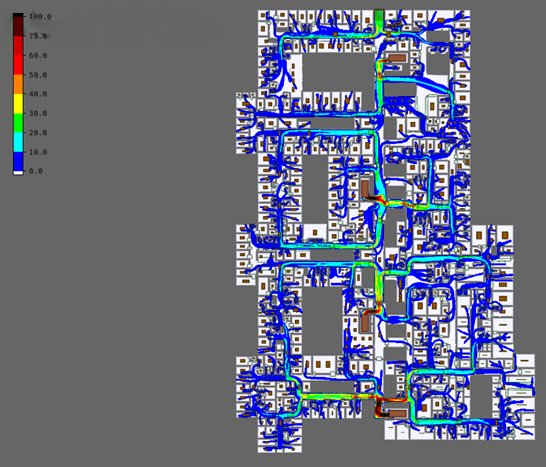Software Used on this Project
Project Overview
In response to the unprecedented demands of the COVID-19 pandemic, healthcare institutions grappled with the need to expand their surge capacity and mitigate the transmission of the virus. Brunel University London spearheaded a research initiative aimed at developing resilient healthcare facilities capable of meeting these demands in the future through advanced computer simulations. Oasys MassMotion was used to evaluate congestion and associated nosocomial infection risk in healthcare facilities. Additionally, MassMotion helped to determine the impact of evacuation scenarios on vulnerable patients. Undergraduate and postgraduate students were actively engaged into the research, which enhanced their understanding of effective and inclusive healthcare resilience design strategies.

MassMotion model – modelled and displayed by Hamzah Khan (MEng Civil Engineering 2023)
How Oasys proved invaluable
Agent-based epidemiological analysis
The resilience of a hospital can be measured by its ability to handle unexpected situations and adapt to new challenges swiftly. Organisational resilience in healthcare is multifaceted, relying on both dynamic clinical protocols and flexible building designs. Dr. Tang’s research critically examines existing hospital intervention strategies and explores the potential of Agent-Based Modelling (ABM) to enhance the control of nosocomial infections.
ABM, a computational framework simulating individual actions and interactions, was employed as part of the research to assess infection risks. The study utilised pedestrian simulation software Oasys MassMotion to conduct spatially explicit stochastic simulations within a virtual hospital setting. By integrating the epidemiological transmission model, such as that of Wells-Riley, with a hospital building model, the research successfully evaluated the impact of patient movements on infection risks.
The behaviour and profiles of the agents in MassMotion can be fully customised, offering precision in simulating patient and staff movement. Grounded in rigorous research, the reliability of various simulations is assured, with agents programmed to avoid collisions and navigate complex environments independently. Customisation options for these agents mean that a variety of scenarios can be modelled to match the unique demands of a healthcare facility. For instance, simulations can include patients waiting for appointments, individuals transporting medical equipment, or those with limited mobility. Such detailed simulations yield results that closely mirror real-life situations, enhancing the safety and efficiency of healthcare operations, improving patient and staff experiences, and reducing the likelihood of costly future modifications to the facility layout.
Incorporating EDI into higher education curriculum
From the 2022-23 academic year , Dr. Tang introduced a significant challenge to the Master of Engineering (Meng) group focusing on Equity, Diversity, and Inclusion (EDI): the task of designing evacuation procedures for patients with mobility issues during fire emergencies. This initiative aimed to address a vital yet often neglected aspect of healthcare modelling, emphasising the importance of inclusive designs that consider the needs of all individuals, particularly the most vulnerable.
The project provided a platform for students to engage in active learning about inclusive design by assuming the roles of healthcare stakeholders. Hamzah Khan, a civil engineering MEng student, participated in the 2023 group project and shared his insights:
“In hospital design, evacuation complexities are heightened by the presence of vulnerable patients. It’s crucial to ensure that escape routes facilitate safe evacuation.”
He emphasised the necessity of modelling evacuation strategies to validate the efficacy of design layouts through rigorous testing. Using MassMotion, Hamzah and his peers were able to shed light on the intricacies involved in evacuating patients. This hands-on experience allowed students to voice concerns about hospital design and engage with local healthcare providers on inclusive design practices.
Dr. Tang remarked on the significance of the project, stating:
“MassMotion brings EDI to the forefront of the Higher Education curriculum.”
This highlights the project’s contribution to enhancing the curriculum by integrating practical challenges that reflect real-world issues and promote a comprehensive understanding of inclusive design principles. The active participation of students into this research project not only contributes to the field but also equips future professionals with the knowledge and skills needed to design inclusive healthcare facilities.
We’d like to thank Brunel University London for sharing this work with us.
If you’d like to share the work you’ve been carrying out using Oasys MassMotion, get in touch! We’d love to collaborate with you.
Are you a university institution inspired by this research? Discover how MassMotion can transform your curriculum with Oasys MassMotion UNIPAC.
